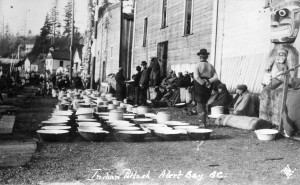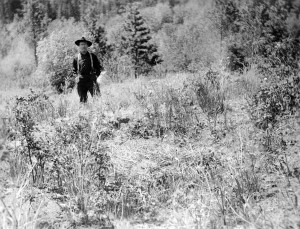What and how do readers make of First Stories in 2014? The readings this week about how stories and storytelling give one’s ownership to their land, and how these stories are built, and built upon, have been particularly challenging. I cannot, and doubt that I ever will fully understand the story by reading these stories of stories. I shall only attempt to dissect it with my understanding, which in itself contains a unique filter constructed by my biological, social, political, and cultural make-up.
Will it ever be possible for us living and reading right now to truly understand the events and experiences of first contacts? Was Wendy Wickwire, who spent more than a decade with Harry Robinson, a rancher, a storyteller and a member of the Lower Similkameen Indian band, able to truly understand his stories? What about the anthropologists, scholars, historians—“recorders” and re-tellers of these first stories—who just like the rest of us, each equipped with their own unique lenses? Who could be considered a reliable source/storyteller?

James Skitt, Matthews, Major. Indian Potlatch Alert Bay, B.C. 1912. Photograph. searcharchives.vancouver.ca. Web. 18 June. 2014.
This gap of time and lives loss “seriously disrupted the continuity and credibility of ascribing land ownership through stories” (Paterson).
As we have gathered from all the readings we have done so far, stories are important to the lives of their “characters”. Brian Thom states in his article, “The Anthropology of Northwest Coast Oral Tradition.” , that “when chiefs tell myths, or rather have a hired speaker tell them at a potlatch feast, storytelling becomes an explicitly political act, authenticating claims to land” (Thom 9). First stories are powerful in that they created the “link of ownership between people and the places” (Paterson). What happens when the link is interfered with? During the time between 1880, 1951, the “telling and retelling of stories at the potlatch, and other similar First Nations institutions across the country, were outlawed by the Indian Act” (Paterson).When residential schools opened in 1834 until the last one closed in 1996, “six generations were cut off from their family stories . . . cut off from knowledge of their clan histories, territorial rights and their languages”, in addition to the violence and abuse with which children, families, and communities were afflicted (Paterson).

Davidson, John F. James Teit with remains of Indian earth oven in Botanie. 1913. Photograph. searcharchives.vancouver.ca. Web. 18 June. 2014.
![Matthews, James Skitt, Major. Hugh Matthews, son [of] Major Matthews, panning gold Similkameen River, near Princeton, 1919 or 1920. 1919/1920. Photograph. searcharchives.vancouver.ca. Web. 18 June. 2014.](https://blogs.ubc.ca/kayiwong490a/files/2014/06/fb63d58b-97c3-4319-85fd-cf38b09284ed-A71051-300x174.jpg)
Matthews, James Skitt, Major. Hugh Matthews, son [of] Major Matthews, panning gold Similkameen River, near Princeton, 1919 or 1920. 1919/1920. Photograph. searcharchives.vancouver.ca. Web. 18 June. 2014.
Stories themselves inherit meaning from other stories. When a story is presented on its own, the story becomes disconnected from the history and the other stories to which it is related. This is why Robinson can never tell his stories briefly, or for a short while.
Each story is not its own entity, it is both the offspring and ancestors of other stories. There is something so beautiful and hopeless about the impossibility to fully make sense of stories, as each of them becomes permeated and gets more entangled, while it is reproduced and consumed by tellers and listeners.
“[T]he stories is worked by Both of us you and I”–Harry Robinson (21).
For Wickwire, she illustrates that the stories she has listened, recorded on tape, jotted down, take a different meaning during subsequent rereadings. Her understanding of Robinson’s stories was enriched by the time spent with Robinson, not just listening to him tell these stories. Stories become more than just stories, they are a meandering of tangible and intangible things. So how could we truly unravel a story through pages of paper. This reminds me again what Harry says of power: for colonizers—for whites—power was “located on paper” (Robinson 16).
-Kayi Wong
Works Cited
Paterson, Erika. “Lesson 2:2.” ENGL 470A Canadian Studies Canadian Literary Genre 98A May 2014. N.p., n.d. Web. 19 June 2014. <https://blogs.ubc.ca/engl47098amay2014/unit-2/lesson-2-2/>.
Robinson, Harry. Living by Stories: a Journey of Landscape and Memory. Ed.Wendy Wickwire. Vancouver: Talon Books. 2005. 1-30. UBC Library. Web. 19 June 2014.
Thom, Brian. “The Anthropology of Northwest Coast Oral Traditions.” Arctic Anthropology 40.1 (2003): 1-28. Project MUSE. Web. 19 June 2014. <http://muse.jhu.edu/>.
